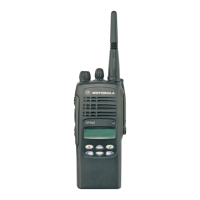Controller Circuits 1-3
3.3 Real Time Clock
(
Refer to Figure 1-3 and the Microprocessor schematic diagram
)
Radios with displays support a Real Time Clock (RTC) module for purposes of message time
stamping and time keeping. The RTC module resides in the microcontroller.The clock uses a back-
up Lithium Ion battery for operating power when the primary battery is removed.
3.3.1 Circuit Description
The RTC module circuit, shown in Figure 1-3, is powered by the ModB/Vstby pin and PI6/PI7 from
the crystal oscillator circuit. A clock frequency of 38.4kHz from a crystal oscillator provides the
reference signal which is divided down to 1 Hz in the processor.
Figure 1-3 RTC Circuit
As the RTC module is powered separately from the processor Vdd, the RTC is kept active through
the ModB / Vstby pin which provides the Lithium battery back-up power when the radio is switched
off.
Table 1-1 Radio Memory Requirements
RADIO ROM (KB)
EXT RAM
(KB)
EEPROM
(KB)
Conventional MDC GP140 128K - 8K
Conventional 5 Tone GP320, GP340 512K 16K 16K
Conventional 5 Tone GP360, GP380 512K 16K 16K
Privacy Plus GP240, GP280 512K 16K 16K
SmartZone GP540, GP580 512K 16K 16K
MPT GP640, GP680 512K 16K 16K
MPT GP1280 512K 16K 16K
LI_ION
R462
R419
3
4
2
15
CR411
1
2
3
Q416
C434
U410
3.3V
3
2
1
VIN
VOUT
VSS
UNSWB+
R460
C435
R461
Vddd
HC11FL0
MODA
MODB
R420
R426
FL401
C436
C437
PI6
PI7
OUT
IN
GND
38.4kHz
UNSWB+
SWB+
6
4
1
3
2
3
51
2
4
CR413
R463
300
Q417
TEST_POINT
TP405
1
BOOT_CTRL

